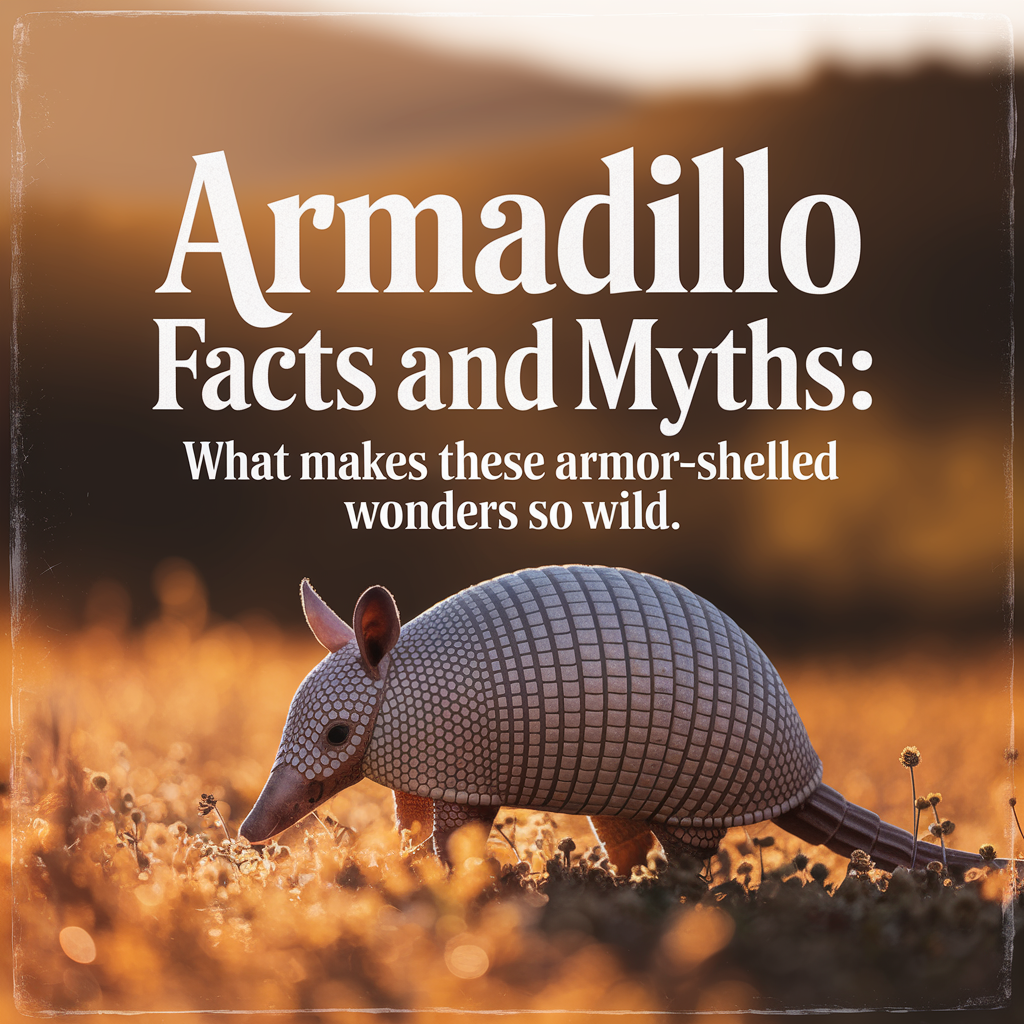
What Exactly Is an Armadillo?
An armadillo is like a mini tank that waddles through the wild. These critters are mammals, but you’d never guess it just by looking. That hard shell on their back? It’s made of bony plates called scutes, giving them armor-like protection that’s one-of-a-kind in the animal kingdom. They belong to the order Cingulata, which makes them distant relatives of sloths and anteaters. Weird combo, right? But it works. With their long snouts, keen sense of smell, and powerful claws, armadillos are built for digging, sniffing out food, and protecting themselves like tiny, roaming dinosaurs.
Evolutionary Relics: Where Did Armadillos Come From?
Armadillos have been walking the Earth for millions of years—literally. They’re evolutionary leftovers from an ancient line of armored animals, most notably the massive glyptodonts, which looked like prehistoric tanks the size of small cars. Fossils tell us armadillos have been around since the Eocene Epoch, about 55 million years ago. They started out in South America and gradually spread north, especially after the continents connected through Central America. Today, they’ve made it all the way up to parts of the U.S., and they’re still marching north.
Meet the Major Species
There are around 21 species of armadillos, but you’ll mostly hear about a few standout stars. The Nine-Banded Armadillo is the only one you’ll find in the U.S.—they’re common in places like Texas, Florida, and even as far north as Illinois now. Then there’s the Giant Armadillo, a South American species that can grow over 3 feet long. And for something downright adorable, look up the Pink Fairy Armadillo—yes, it’s real. It’s tiny, fuzzy, and almost looks like a Pokémon. Each species has different habits, appearances, and ranges, but all come wrapped in their signature bony armor.
Armor and Anatomy: Built Like a Tank
The first thing people notice about armadillos? That tough-looking shell. Their armor is made of overlapping bony platescovered by a tough layer of skin and keratin (same stuff your fingernails are made of). It’s not bulletproof, but it’s great for protection against predators. Most species can’t roll up into a ball (despite the cartoons), but a few, like the Three-Banded Armadillo, actually can. Their claws are another big deal—perfect for tearing up soil in search of bugs and building deep, complex burrows.
Where Armadillos Roam
Most armadillos stick to Central and South America, but the Nine-Banded Armadillo is now cruising around the southern and central United States. Thanks to climate change and fewer cold winters, they’re expanding their territory every year. These creatures prefer warm, moist environments with soft soil—perfect for digging. You’ll find them near forests, grasslands, and even golf courses or backyards if the soil’s right. Don’t be surprised if one wanders through your yard in search of a snack.
Burrow Builders: Home Sweet Underground Home
Armadillos are serious diggers. A single armadillo can create multiple burrows, each around 7 feet long and up to 15 feet deep. That’s a lot of dirt moved by such a small animal! These burrows provide shelter from predators and extreme heat, and they often have multiple entrances and exits. Some homeowners find these holes annoying, especially when they show up near foundations or gardens, but to armadillos, it’s just a cozy little hideout.
Nocturnal Foraging and Food Habits
These guys are nighttime wanderers. After the sun goes down, armadillos get to work, using their powerful sense of smell to sniff out insects, grubs, and even small reptiles or amphibians. Their diet is mostly made up of bugs like ants and termites, but they’ll also eat plants, fruit, and sometimes even roadkill. That long sticky tongue? Perfect for scooping up bugs in tight spaces. It’s like nature’s version of a claw machine—except it actually works.
Impressive Abilities: Jumping, Swimming, and Breath Holding
Armadillos are surprisingly athletic for their size. Startle one and it can jump straight up into the air—which doesn’t always help it dodge a car, unfortunately. Some can swim across rivers, holding their breath for up to six minutes. They inflate their stomachs and intestines to float, which is just plain wild. Others walk along the riverbed. However they do it, these critters are more capable than they look.
Born Identical: Armadillo Reproduction
The Nine-Banded Armadillo has one of the most unusual reproductive quirks in the animal world: every pregnancy produces identical quadruplets—four babies from the same egg, genetically the same. It’s like cloning, nature-style. This rare trait is a big reason why armadillos are studied in science labs. Female armadillos also practice delayed implantation, meaning they can delay pregnancy after mating to better time when the babies are born.
Survival Tactics: Armor and Bluff
While only a few armadillo species can actually curl into a ball, all of them rely on their armor as the first line of defense. If that doesn’t work, they’ll dig in fast, disappearing underground in seconds. Some freeze when they sense danger, which may help them avoid predators. And if you thought armadillos were slow, think again—many can sprint short bursts surprisingly fast to escape danger. They’re not just armored—they’re sneaky too.
Why Do Armadillos Get a Bad Rap?
Let’s be real—armadillos don’t have the best public image. A lot of folks see them as pests that tear up gardens or dig holes in the yard. And yeah, they can be a little destructive. But remember, they’re not trying to ruin your landscaping—they’re just hunting bugs and looking for shelter. With a little patience and maybe a small fence or two, most problems can be managed. Plus, if you’re dealing with grubs or termites, these guys are your best friend.
Do Armadillos Really Carry Leprosy?
This is a common worry, especially in parts of the southern U.S. Yes, armadillos can carry the bacteria that causes leprosy (Hansen’s disease), but it’s rare for humans to catch it from them. Transmission usually happens with prolonged direct contact—so no, seeing one in your yard isn’t a health emergency. Just don’t handle wild armadillos or try to keep them as pets. Admire them from a safe distance and you’ll be just fine.
Common Armadillo Myths Busted
There are plenty of myths about armadillos. Some people think all of them roll into a ball—nope, only a couple species do that. Others believe they’re blind or dumb—again, not true. While their eyesight isn’t great, their sense of smell and ability to solve problems is pretty impressive. And the idea that they’re useless pests? Totally wrong. They help control insect populations and are key to their ecosystems.
Can Armadillos Be Helpful to the Environment?
Absolutely. Armadillos are natural pest control—eating thousands of insects each week, including beetles, termites, ants, and other critters that would otherwise mess with crops or gardens. Their digging also aerates the soil, improving water flow and helping plants grow. Some animals even use abandoned armadillo burrows for shelter, making these armored diggers an important part of their local habitats.
Tracking Armadillos: Signs One’s Been in Your Yard
Think you’ve got an armadillo in the neighborhood? Look for shallow holes in the lawn, about 3–5 inches wide. You might also see burrow entrances near the base of structures or under bushes. They usually come out at night, so setting up a trail cam can confirm the mystery. Unlike raccoons or possums, armadillos don’t go after your trash—they’re only after bugs.
Should You Relocate an Armadillo?
If an armadillo is tearing up your yard, relocation might seem like a quick fix—but it’s not always the best move. In many places, it’s illegal to trap or relocate wildlife without a permit. Plus, armadillos are territorial and may not survive well in a new area. Instead, try making your yard less inviting: remove excess brush, fence off problem areas, and use motion-activated sprinklers or ultrasonic repellents. They’ll usually move along on their own.
Are Armadillos Dangerous to Pets?
Not usually. Armadillos are shy, non-aggressive animals. They won’t bite, scratch, or go after your dog or cat. But they can carry diseases like leprosy or parasites like ticks, so you still don’t want your pet messing with one. The bigger issue is your dog digging up the yard to try and chase them—which, let’s be honest, is pretty on-brand for most dogs.
How to Keep Armadillos Out of the Garden
If your vegetable garden is starting to look like Swiss cheese thanks to an armadillo, it’s time to act. Use fencing that goes at least 12 inches underground, since they’ll dig right under shallow barriers. Motion lights, garden-safe repellents, and even certain smells (like vinegar or castor oil) can sometimes make them think twice about hanging around. But the key is making your yard less appealing for bugs—because no bugs means no buffet.
Weird Armadillo Facts You’ll Want to Tell Someone
- Armadillos are the only mammals with a true shell.
- They can jump 3 to 4 feet straight into the air when startled.
- They’re born fully formed with their armor already in place—like tiny, walking helmets.
- Some can hold their breath for 6 minutes underwater.
- Armadillos have very few teeth, and none are sharp—just tiny, peg-like grinders.
These oddballs of the animal world are packed with surprises and don’t get nearly enough credit.
Why We Love (and Respect) These Odd Little Creatures
Armadillos might not be cute in the traditional sense, but they’re fascinating. They’ve survived millions of years, adapted to different climates, and help clean up the ecosystem—all while looking like they walked straight out of a prehistoric comic book. Whether you’re watching one dig a hole in your backyard or learning about them online, they’re one of those animals that just makes the world a little more interesting.



